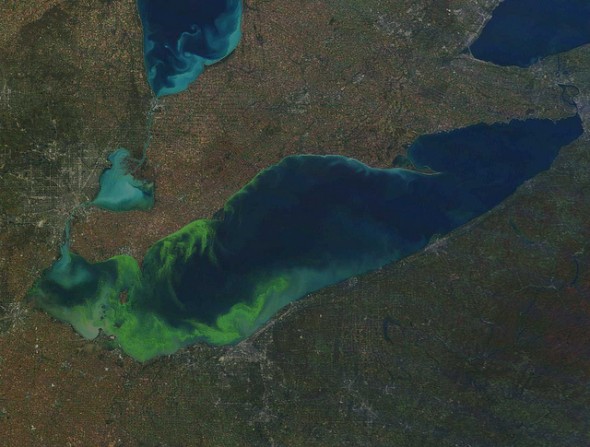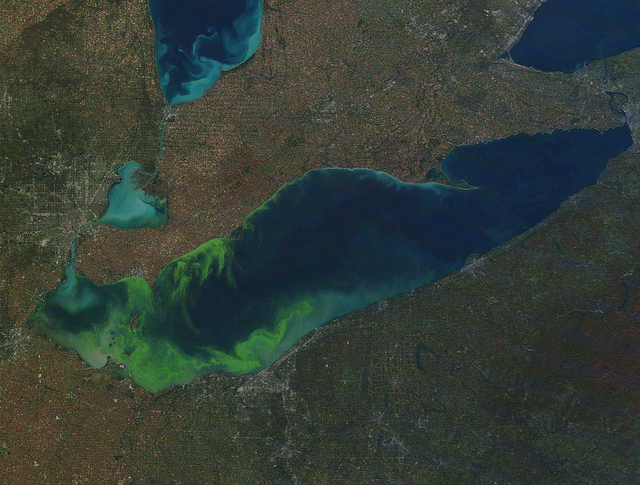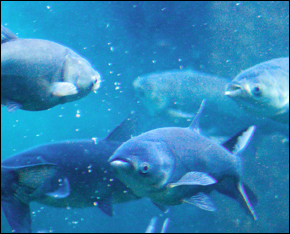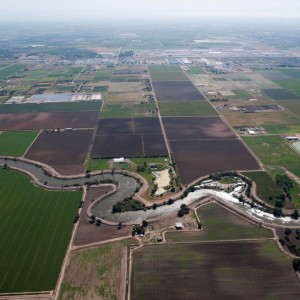Cause of Lake Erie’s Harmful Algal Blooms Gains More Certainty
New research finds that agricultural practices lead to biggest threat to water quality and health in the Great Lakes.

By Codi Kozacek
Circle of Blue
Changes in the timing and method of applying agricultural fertilizer are the primary drivers behind the increasing amounts of phosphorus entering Lake Erie and causing toxic algal blooms and a large dead zone, according to new basin-wide scientific studies. The studies, drawing on institutions from across the Great Lakes, also found that climate change is increasing the urgency of developing ways to keep fertilizers on fields, and may mean that larger reductions in phosphorus will be necessary to alleviate Great Lakes algal blooms.
Algal blooms and dead zones in Lake Erie were severe during the 1960s, caused primarily by large releases of phosphorus from sewage and industrial plants. The 1972 federal Clean Water Act and the 1978 bi-national Great Lakes Water Quality Agreement led to dramatic reductions in phosphorus from these sources and a rapid improvement in water quality.
Lake Erie, however, saw a reemergence of the algal blooms and the growth of the dead zone in the mid-1990s, and the problems are worsening. In 2011, for example, Lake Erie experienced its most severe bloom of toxic algae on record. Last fall a toxic algal bloom in the lake forced officials to shut off a public water supply system in Ohio.

The new studies, part of the Ecological Forecasting (EcoFore) Lake Erie project led by researchers at the University of Michigan, found that the current targets to reduce phosphorus to alleviate algal blooms in Lake Erie may not be low enough to revive the dead zone. That conclusion informed the International Joint Commission’s recommendations in February for improving Lake Erie’s water quality.
The findings, and those of other studies from across the Great Lakes region, are delivering an ever clearer picture of the specific causes of nonpoint phosphorus runoff, algal blooms, and dead zones. The basic drivers of these problems are no longer unknown. The new research fills a critical void in information that has been often cited as a reason that strict regulations on nonpoint pollution sources, including agriculture, were not regulated under the 1972 federal Clean Water Act.
The new research shows that although the total amount of phosphorus entering the lake has remained relatively steady and below target levels set by the Great Lakes Water Quality Agreement (GLWQA), a nonbinding agreement between the United States and Canada aimed at protecting the big lakes, there has been a marked increase in the proportion of dissolved reactive phosphorus (DRP)—a form that is nearly 100 percent available for the algae to use.
Researchers are now closing in on what caused the spike in dissolved phosphorous. “What we found is that it is a combination of agricultural practices that have been put in place since the late 1980s and into the 2000s, combined with increased storms, particularly higher intensity spring rain events,” Don Scavia, director of the Graham Sustainability Institute at the University of Michigan, told Circle of Blue. Scavia is the principal investigator of the EcoFore Lake Erie project.
According to models used in the EcoFore project, climate changes alone would not be enough to create the observed rise in dissolved reactive phosphorous. Instead, the models showed that current weather patterns, when coupled with agricultural conditions in the 1970s, did not create a problem.
“We reversed the order of the years in the model and we did not get a big influx of DRP,” Scavia said. “So it’s not the storms alone, but rather a combination of storms and new agricultural practices. At least, that’s what the model shows.”
Changes in agricultural practices include:
• A shift toward more fall fertilizer applications instead of spring applications.
• The use of broadcast fertilizer applications that do not incorporate fertilizer into the soil.
• An increase in no-till field management that leads to a build-up of phosphorus in the top layers of soil.
Unexpected Outcomes of Practices Thought to be Better
Nonetheless, returning to past agricultural practices would not fix Lake Erie’s water quality problems, according to Anna Michalak, a professor at the Carnegie Institution for Science at Stanford University. Michalak is the principal investigator for a National Science Foundation-supported climate and water quality project in the Great Lakes basin that is bringing together nearly 30 researchers from various academic disciplines.
“It’s not that the [current] agricultural practices are ‘bad’ per se,” Michalak told Circle of Blue. “A lot of agricultural practices that are leading to more nutrient loading were actually implemented for sound environmental reasons.”
Conservation tillage and no-till practices, for example, help farmers reduce soil erosion and keep organic material in the soil. However, by not turning the soil over, the practices also concentrate fertilizers near the surface where they are more likely to flow off of the land during strong storms.
“Going back to the way things were would be no panacea,” Michalak said. “We would see the erosion issues we were seeing before. We need to be looking for practices that contribute to overall environmental health, and benefit both the farmers and the lake. On a fundamental level, farmers are not interested in fertilizing the lake; they’re interested in fertilizing the field.”
Climate Problems Lie in Extremes
Compounding the changes in agricultural practices are changes in climate in the Great Lakes region, which could affect water quality in the lakes.
“In the Great Lakes we’re not seeing a clear signal from climate models in changes of total amount of precipitation, but the models do predict a change in when that precipitation will occur, with stronger events in spring” Michalak said.
“They also anticipate more events that are at the extremes—either very large storms or very dry periods that might average out to something similar like today,” she added.
Heavy rainstorms and droughts could both have effects on Lake Erie water quality. A series of intense spring storms in 2011, for example, drove a record algal bloom in the lake that summer. Other factors, like temperature and winds that drive lake circulation, also play a role in the size and intensity of algal blooms. Weak wind patterns and reduced lake circulation in 2011 allowed the large amounts of phosphorus washed into the lake by spring storms to sit in the western basin for longer than normal, leaving huge amounts available to feed algae once warm summer temperatures arrived.
No Simple Fix to Water Quality Problems
The U.S.-Canada International Joint Commission has recommended a 39 percent cut in the average annual phosphorus contributed by the Maumee River to reduce harmful algal blooms, but a 46 percent cut in the average annual phosphorus load in Lake Erie’s central and western basins to reduce the hypoxic dead zone. Moreover, the EcoFore project, which informed the IJC’s recommendations on hypoxia, found that DRP loads needs to be reduced 78 percent from the 2005-2011 average in order to restore the dead zone to conditions seen in the 1990s.
“The same driver of the very visible, toxic blooms in the western basin is driving the hypoxia [in the central basin],” Scavia said. “It’s phosphorus, and we need to deal with that for both hypoxia and for harmful algal blooms. But what we caution in our paper is that it’s not clear that if you only address the load driving the toxic algae, whether it will be enough to also take care of the hypoxia problem. You need to look at them as a coupled set. Both are water quality problems. Both impact tourism and fisheries. And both are driven by excess phosphorus loads.”
In addition to releases of phosphorus from the Maumee and Sandusky rivers in spring, which drive the harmful algal blooms and represent about half of the total phosphorus entering Lake Erie, hypoxia is also driven by loads of phosphorus from the Detroit River and tributaries flowing into the lake’s central basin. Hence, focusing on one river may improve algae conditions, but not the dead zone.
“Just dealing with the Maumee is not going to fix the hypoxia problem,” Scavia said.
Michalak also acknowledged the complicated relationship between nutrient loading and algal blooms and hypoxia.
“Both of them on a base level are affected by inputs of nutrients and especially phosphorus into the lake caused by human activity,” she said. “Nutrients make both worse, but the discharge appears to be affecting them in different ways. They are subtle processes that we don’t fully understand and that we are currently looking into.”
A news correspondent for Circle of Blue based out of Hawaii. She writes The Stream, Circle of Blue’s daily digest of international water news trends. Her interests include food security, ecology and the Great Lakes.
Contact Codi Kozacek










Good article but hypoxia is reduced oxygen (low concentration), not the lack of it. The lack of oxygen is called anoxia.
Mark